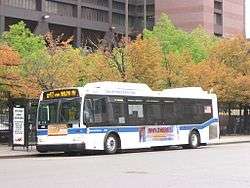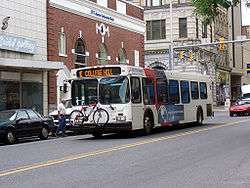Spanish Transportation
Spanish Transportation, officially Spanish Transportation Service Corporation, and operating under the name Express Service, is a privately operated bus company, which leases minibuses to individual operators, who provide service in and between various communities in northeastern New Jersey and to Manhattan in New York City. The fleet consists mostly of jitneys that are colloquially known as dollar vans or guaguas.
Routes
The company, which was started in 1993 and carries up to 40,000 passengers per day, has several routes that parallel and thus augment and compete with New Jersey Transit bus operations.[1][2][3] In general, Spanish Transportation jitneys are slightly less expensive (for an adult buying one-way passage; but they are more expensive for children under 12, senior citizens, and some disabled passengers who qualify for reduced NJ Transit fares, they are not an option for disabled passengers in wheelchairs, and they neither offer discounts nor honor NJ Transit Monthly or Weekly Passes) and significantly more flexible with pickup and drop-off locations and payment.[1][2] The company's primary routes are: Paterson, New Jersey to Port Authority Bus Terminal (PABT), by way of Passaic, Clifton, Rutherford and Union City, and also letting off passengers on Manhattan streets nearby the PABT, identical to NJT's #190 route. Another route goes from Journal Square in Jersey City to the Port Authority. The Broadway route goes: inbound (Eastbound) primary route on Broadway from its Southwest corner with Washington Street (one block East of Main Street), Paterson; continuing on Broadway as it gains the name Martin Luther King Jr. Way and the designation at the western terminus, which turns back into Broadway; crossing the Passaic River and all of Bergen County starting at the Paramus border where Broadway loses the name, as it becomes NJ Highway Route 4 (with a small detour to and from the northern bus stop near Entrance 10 to the Westfield Garden State Plaza mall in Paramus during mall and theatre operating hours except on Sundays), losing the designation Route 4 at the eastern terminus; merging with Interstate 95 and the George Washington Bridge (over the Hudson River) and approaches in Fort Lee and Manhattan; to George Washington Bridge Bus Terminal identical to NJT's #171 route; the outbound (Westbound) return route is very similar, but its last stop is one block West, on West Broadway at its five-way corner with Broadway and Main Street in Paterson. Buses traveling the Broadway route do not stop adjacent to Eastside Park in Paterson (East of 32nd Street) because NJ Transit Bus 770 detours two blocks North on 11th Avenue from 33rd Street to 43rd Street and Paterson has not seen fit to post bus stop signs there; thus there are no bus stops at which to stop.[4]
Terminals

The company rents space across Broadway from Broadway Bus Terminal in Paterson and in Port Authority Bus Terminal (PABT) on 42nd Street and George Washington Bridge Bus Terminal in Manhattan[4]
Jitneys in North Jersey
In addition to Spanish Transportation owned vehicles, numerous other jitneys provide service in North Jersey, particularly Hudson County along Bergenline Avenue, Boulevard East, and Palisade Avenue. Studies were conducted to better regulate and incorporate the jitney system, which has grown since 2000.[5][6][7][8] Legislation to regulate them has been introduced in the New Jersey Legislature.[9][10][11]
Many jitneys, including some of those owned by Spanish Transportation, use local streets in the vicinity of the PABT, namely 42nd Street, as a drop-off and pick-up point for passengers and parking, which has led to congestion and complaints.[12][13]
References
- 1 2 Michaels, David (May 23, 2007), "Jitneys attracting riders, rivals on Paterson-to-N.Y. commute", The Record, retrieved April 29, 2012
- 1 2 "Jitney minibuses offer a cheaper option for N.J. passengers, but ride can be risky", The Star Ledger, July 11, 2010, retrieved April 29, 2012
- ↑ Tirella, Tricia (July 25, 2010), "Fierce competition surrounds jitney buses", Hudson Reporter, retrieved April 29, 2012
- 1 2 "Express Service - Bus Terminals (Where Do You Want to Go)". Spanish Transportation. Archived from the original on October 6, 2012. Retrieved May 14, 2013.
- ↑ Smith, Stephen (September 17, 2010). "North Jersey jitneys take off". Market Urbanism. Retrieved April 30, 2012.
- ↑ "Hudson County Jitney Study". North Jersey Transportation Planning Authority. 2010-. Retrieved April 20, 2012. Check date values in:
|date=(help) - ↑ Urbitran Associates (November 2007). "Final Report" (PDF). Hudson County Bus Circulation and Infrastructure Study. North Jersey Transportation Planning Authority. Retrieved April 20, 2012.
- ↑ New Jersey Transit; et al. (November 2009). "Executive Summary" (PDF). Final Report Jersey City Local Bus Study. NJ Transit. Retrieved April 20, 2012.
- ↑ http://legiscan.com/NJ/text/A4546/2012
- ↑ http://www.nj.com/hudson/index.ssf/2014/01/bill_to_make_jitney_owners_operators_more_accountable_okd_by_assembly_panel.html
- ↑ http://www.nj.com/hudson/index.ssf/2016/11/local_government_one_step_closer_to_jitney_bus_con.html
- ↑ Knafo, Saki (October 5, 2008), "A Glut of Buses at the Crossroads of the World", The New York Times, retrieved April 30, 2012
- ↑ Duane, Thomas K. (October 12, 2008), "New Bus Rules and New Yorkers Who Point the Way: Putting The Brakes On Buses That Clog Up the Streets", The New York Times, retrieved April 30, 2012
External links
- Map
- Spanish Transportation website Archived 9 December 2012; mostly in Spanish
- Drivers of Jitney buses doubt the purpose of random inspections in Hudson County YouTube NJNews12 Video in Spanish (uploaded October 7, 2011)
- Assembly panel tackles dangers of minibuses
- Jitney bus safetuy hearing held today in Hoboken
- Jitney Buses of New Jersey




.jpg)
